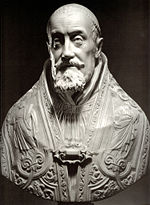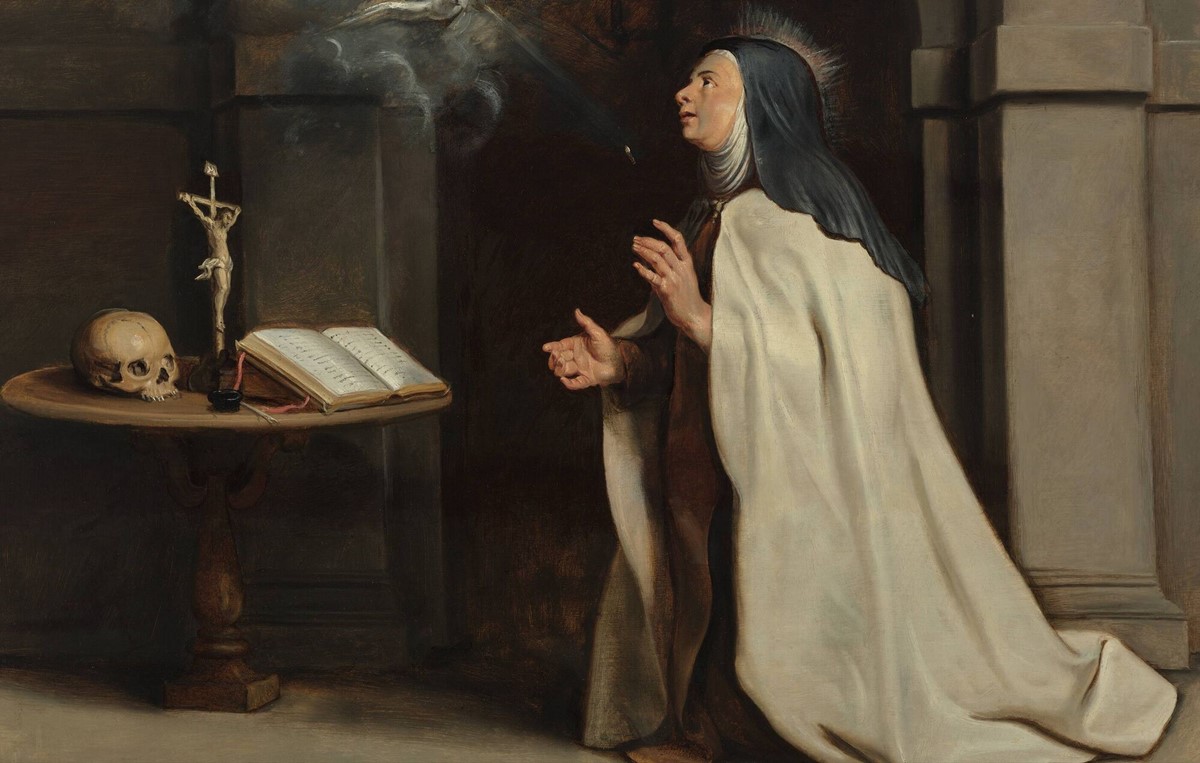“The Ecstasy of Saint Teresa, by Bernini…”
* * * *
The next Feast Day of interest is Thursday, October 15. That’s the Feast of St. Teresa of Ávila.
 St. Teresa was recently dubbed “the Pope Francis of her time,” but there’s more on that later. There’s also more about her talking to God and saying, “If this is how you treat your friends, no wonder you have so few!” (Note too that “feast” here doesn’t refer to a large meal – as in a celebration – but rather to an religious celebration dedicated to a particular saint.)
St. Teresa was recently dubbed “the Pope Francis of her time,” but there’s more on that later. There’s also more about her talking to God and saying, “If this is how you treat your friends, no wonder you have so few!” (Note too that “feast” here doesn’t refer to a large meal – as in a celebration – but rather to an religious celebration dedicated to a particular saint.)
I’ve written about Teresa before. See On the Bible and mysticism, and On the Christian repertoire. (See also Teresa of Avila, Nun, which includes the Bible readings for the Day.)
The point being that Teresa was a mystic before that became a bad word:
The terms “mystic” or “mysticism” seem to throw Southern Baptists and other conservative Christians into apoplexy. (Try it sometime!!!)
That was a bit of sarcasm from The Bible and mysticism, but enough of my ramblings. (For now anyway.) Here’s what Wikipedia said about how Teresa got started as a mystic:
Teresa entered a Carmelite Monastery of the Incarnation in Ávila, Spain [in November 1535, but] found herself increasingly in disharmony with [its] spiritual malaise… The daily invasion of visitors, many of high social and political rank, vitiated the atmosphere with frivolous concerns and vain conversations. These violations of the solitude absolutely essential to progress in genuine contemplative prayer grieved Teresa…
Frivolous concerns? Vain conversations? That sounds just like today!
 More to the point, AmericanCatholic.org noted that Teresa “lived in an age of exploration as well as political, social and religious upheaval. It was the 16th century, a time of turmoil and reform.” That is, she was born in 1515, a mere two years before Martin Luther – seen at right as a “friar, with tonsure” – nailed his 95 Theses to the door of All Saints’ Church in Wittenberg. (Thus starting the Protestant Reformation.)
More to the point, AmericanCatholic.org noted that Teresa “lived in an age of exploration as well as political, social and religious upheaval. It was the 16th century, a time of turmoil and reform.” That is, she was born in 1515, a mere two years before Martin Luther – seen at right as a “friar, with tonsure” – nailed his 95 Theses to the door of All Saints’ Church in Wittenberg. (Thus starting the Protestant Reformation.)
But getting back to the idea of “mystic” freaking out some Christians. An example: “The term ‘Christian mystic’ is an oxymoron. Mysticism is not the experience of a Christian.” That’s from What is Christian mysticism? – GotQuestions.org. Or this:
Mysticism is when you get into a mystical state and it’s something you cannot understand, you’re out there in “la-la” land, it’s an “oooh” experience and you’re really not thinking.
See Is There A Biblical Mysticism? | thebereancall.org. (About one “click” down).
On the other hand, see Mysticism – Wikipedia. That said the term originally “referred to the biblical, the liturgical and the spiritual or contemplative dimensions in early and medieval Christianity.” And the article Teresa of Ávila – Wikipedia noted in pertinent part that “Teresa’s writings, produced for didactic purposes, stand among the most remarkable in the mystical literature of the Catholic Church.” (So you’re going to argue with the Catholic Church?)
All of which I noted in On the Bible and mysticism. In the post On the Christian repertoire, I included the image at the bottom, “The Appearance of the Holy Spirit before Saint Teresa.” And a note to that post pointed out that an internet search will generally lead the searcher to the definition of mystic as “a person who seeks by contemplation and self-surrender to obtain unity with or absorption into the Deity or the absolute. . .”
In other words, a mystic is a person who seeks to become “one” with both God and his or her neighbor. Not unlike Francis of Assisi. (Who no doubt some contemporaries thought himself was a bit of a weirdo…) See also The basics.
And speaking of “absorption into oneness:” That seems to be what Jesus spoke of as He prayed in John 17:20-23. He was in the Upper Room the evening before the Crucifixion, and asked God to help His followers:
“I ask . . . on behalf of those who will believe in me . . . that they may all be one. As you, Father, are in me and I am in you, may they also be in us, so that the world may believe that you have sent me. The glory that you have given me I have given them, so that they may be one, as we are one, I in them and you in me, that they may become completely one. . .”
On that note, focus especially on John 17:21, John 17:22, and John 17:23. John 17:21 reads – in pertinent part – “ that all of them [that’s us] may be one, Father, just as you are in me and I am in you.” John 17:22 reads – ditto – “that they may be one as we are one.” John 17:23, reads – one last ditto – “I in them and you in me – so that they may be brought to complete unity.”
Then too, that seems to be just what one “Common Prayer” means when it said that all Christians – by and through sharing Holy Communion – are in the process of becoming “very members incorporate in the mystical body of thy Son.”
But we were talking about Teresa of Avila.
Among the Bible readings for her day, the first – Romans 8:22-27 – includes one of my favorite verses. Romans 8:26 is especially useful when you’re not sure how to pray or what to pray for: “the Spirit helps us in our weakness; for we do not know how to pray as we ought, but that very Spirit intercedes with sighs too deep for words.” (And that “sighs too deep for words” is one of my favorite translations…)
But back to Teresa. She was born in 1515 and died in 1882, at the then-ripe-old-age of 67. She was a devout “theologian of contemplative life through mental prayer.”
 In 1622 she was canonized by Pope Gregory XV – seen at right – and in 1970 was named a Doctor of the Church by Pope Paul VI. And in March, 2015 – as noted – St. Teresa of Avila [was] dubbed the Pope Francis of her time.
In 1622 she was canonized by Pope Gregory XV – seen at right – and in 1970 was named a Doctor of the Church by Pope Paul VI. And in March, 2015 – as noted – St. Teresa of Avila [was] dubbed the Pope Francis of her time.
Witty, warm and personable, she nonetheless pushed the Carmelite order to reform. St. Teresa taught the faithful not to be caught up with creature comforts, to be true to their vocation and to dedicate hours each day to contemplative Carmelite prayer.
Somewhat surprisingly, she was “of Jewish descent,” and among other things could be rather droll. (If not apparently disrespectful to God.) According to one story, she was traveling to visit another convent when her cart overturned and she was thrown into a mud puddle. Embarrassed at having to show up in a dirty habit, Teresa reportedly prayed, “God, if this is how you treat your friends, no wonder you have so few!”
But seriously, today she is perhaps best known as a mystic. However, even when she was alive – a long time ago – some people considered that bad. As Wikipedia noted, “Around 1556, various friends suggested that her newfound knowledge was diabolical, not divine. ”
So some people have always been offended by the terms ‘mystic” and “mysticism.”
On that note, it can’t be denied that there are a lot of weirdos out there calling themselves “mystics.” But by the same token, there are a lot of people learning karate for all the wrong reasons. (How many “hypocritical” karate students want to learn how to beat the tar out of people they don’t like?) For example, see Deshimaru’s The Zen Way to Martial Arts:
Many people these days come to the martial arts as if to a sport or, worse, as if seeking an effective instrument of aggression and domination. And, unhappily, there are studios that cater to this clientele. Violent and exploitative martial arts movies contribute to the corruption…
But does that make “traditional” karate training any less valid? In the same way, does the existence of some “hypocritical” Christians make the entire faith invalid? Then too, how many Christians seem to view their faith as an “instrument of aggression and domination?”
That wasn’t Teresa’s way. As the Collect of her Feast Day recalls:
God, by your Holy Spirit you moved Teresa of Avila to manifest to your Church the way of perfection: Grant us, we pray, to be nourished by her excellent teaching…
* * * *

“The Appearance of the Holy Spirit before Saint Teresa of Ávila…”
* * * *
The upper image is courtesy of Teresa of Ávila – Wikipedia. The full caption: “The Ecstasy of Saint Teresa by Bernini, Basilica of Santa Maria della Vittoria, Rome.”
The Pope Francis image is courtesy of Pope Francis – Wikipedia. The caption: “Francis among the people at St. Peter’s Square.”
See an image of Francis of Assisi at Mysticism – Wikipedia, with the caption: “Life of Francis of Assisi by José Benlliure y Gil.”
For more on Teresa of Avila, see Selections Of An Interview – St Teresa Of Jesus. (One of her other names.) Note that she is not to be confused with Thérèse of Lisieux (1873-1897), best known for her “Little Way” method of what might be called “life meditation.” See Wikipedia and also St. Therese and Her Little Way – Society of the Little Flower:
St. Therese believed that the people of her time lived in too great fear of Gods judgment… [She] translated “the little way” in terms of a commitment to the tasks and to the people we meet in our everyday lives… Her life sounds so routine and ordinary, but it was steeped in a loving commitment that knew no breakdown. It is called a little way precisely by being simple, direct, yet calling for amazing fortitude and commitment.
The “Common Prayer” quote is from page 339 of the Book of Common Prayer. See the full prayer on The Online Book of Common Prayer, at the end of The Holy Eucharist: Rite One.
Re: “Deshimaru’s The Zen Way to Martial Arts.” The full title of the Amazon book is The Zen Way to Martial Arts: A Japanese Master Reveals the Secrets of the Samurai. The quote itself is from the 1991 Arkana Books edition, translated by Nancy Amphoux.
Also on page 3, Deshimaru told of a student who asked, “How many years do I have to practice Zazen?” (The meditation technique used by Zen masters.) His answer, “Until the day you die.” (For what that’s worth.) Taisen Deshimaru (1914-1982) “was a Japanese Sōtō Zen Buddhist,” who founded the Association Zen Internationale. During World War II:
Deshimaru was exempted from the Imperial Japanese Army because of his near-sightedness. He went to the island of Banka, Indonesia, to direct a copper-mine. He found himself on the island of Bangka, where he taught the practice of zazen to the Chinese, Indonesian, and European inhabitants. He defended inhabitants against the violence of his own people, and was therefore thrown in jail, but released by “the highest military authorities in Japan.” (E.A.)
Re: Some Christians using the faith as an “instrument of aggression and domination.” See also Dark side (Star Wars) – Wikipedia: “The dark side of the Force is a fictional moral, philosophical, metaphorical and psychic concept in the Star Wars universe created by George Lucas. The Force is a mystical energy which permeates the Star Wars galaxy; its dark side represents an aspect of it that is not practiced by the Jedi who view it as evil.”
The lower image is courtesy of Mysticism – Wikipedia. The full caption: “The Appearance of the Holy Spirit before Saint Teresa of Ávila, Peter Paul Rubens.”
* * * *